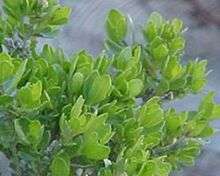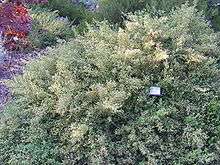Baccharis pilularis
| Baccharis pilularis | |
|---|---|
 | |
| Scientific classification | |
| Kingdom: | Plantae |
| (unranked): | Angiosperms |
| (unranked): | Eudicots |
| (unranked): | Asterids |
| Order: | Asterales |
| Family: | Asteraceae |
| Genus: | Baccharis |
| Species: | B. pilularis |
| Binomial name | |
| Baccharis pilularis DC. | |
| Synonyms[1] | |
| |


Baccharis pilularis, called coyote brush[2] (or bush), chaparral broom, and bush baccharis, is a shrub in the daisy family native to California, Oregon, Washington, and Baja California.[3] There are reports of isolated populations in New Mexico, most likely introduced.[4][5][6]
Distribution
The plants are found in a variety of habitats, from coastal bluffs, oak woodlands, and grasslands, including on hillsides and in canyons, below 2,000 feet (610 m).
Coyote brush is known as a secondary pioneer plant in communities such as coastal sage scrub and chaparral. It does not regenerate under a closed shrub canopy because seedling growth is poor in the shade. Coast live oak, California bay, Rhus integrifolia, and other shade producing species replace coastal sage scrub and other coyote bush-dominated areas, particularly when there hasn't been a wildfire or heavy grazing.
In California grasslands, it comes in late and invades and increases in the absence of fire or grazing. Coyote bush invasion of grasslands is important because it helps the establishment of other coastal sage species.
Description
The Baccharis pilularis shrub is generally smaller than 3 metres (9.8 ft) in height. Erect plants are generally mixed (and intergrade completely) with prostrate plants. It is glabrous and generally sticky.[7]
The stems are prostrate to erect which branches spreading or ascending. The leaves are 8–55 millimetres (0.31–2.17 in) long and are entire to toothed and oblanceolate to obovate, with three principal veins.[7]
The flower heads are in a leafy panicle. The involucres are hemispheric to bell shaped. This species is dioecious (pistillate and staminate flowers occur on separate plants). Both staminate and pistillate heads are 3.5–5 millimetres (0.14–0.20 in) long. Phyllaries are in 4–6 series, ovate, and glabrous. The receptacles are convex to conic and honeycombed. The staminate flowers range from 20–30 and there are 19–43 pistillate flowers.[7]
This and other Baccharis species are nectar sources for most of the predatory wasps, native skippers (small butterflies), and native flies in their ranges.
- Baccharis pilularis subsp. consanguinea(DC.) C.B.Wolf — primarily in coastal chaparral
- Baccharis pilularis subsp. pilularis — sandy coastal bluffs and beaches in California.
Cultivation
Baccharis pilularis is cultivated as an ornamental plant, and used frequently in drought tolerant, native plant, and wildlife gardens; and in natural landscaping and habitat restoration projects. The cultivar ground cover selections have various qualities of height and spread, leaf colors, and textures. The upright forms are useful for hedges and fence lines, and year-round foliage.
Coyote brush is usually deer-resistant. The plants are also drought tolerant after maturity, requiring watering once a week until established, and then about once per month during the first summer. They can mature in one to two years. The plants prefer good drainage.
Only male plants of Baccharis pilularis are cultivated for landscaping use. If these are substituted for Baccharis pilularis subsp. consanguinea in ecological restoration, there will not be as much seed set, nor recruitment of new individuals.
Cultivars
Cultivars, often with the common name "dwarf coyote brush" or "dwarf baccharis" indicating ground cover selections, include:
- Baccharis pilularis 'Pigeon Point'—from Pigeon Point, California coast.[8]
- Baccharis pilularis "Twin Peaks"—from coast along Sonoma to Monterey Counties.[9]
- Baccharis pilularis 'Santa Ana' [10]
See also
- California coastal sage and chaparral ecoregion
- California montane chaparral and woodlands ecoregion
- Fire ecology
References
- 1 2 The Plant List Baccharis pilularis DC.
- ↑ Steinberg, Peter D. (2002). "Baccharis pilularis". Fire Effects Information System (FEIS). U.S. Department of Agriculture (USDA), Forest Service (USFS), Rocky Mountain Research Station, Fire Sciences Laboratory. Retrieved 26 May 2015 – via https://www.fs.fed.us/database/feis/.
- ↑ CONABIO. 2009. Catálogo taxonómico de especies de México. 1. In Capital Nat. México. CONABIO, México D.F..
- ↑ "Baccharis pilularis". Natural Resources Conservation Service PLANTS Database. USDA. Retrieved 23 March 2013.
- ↑ The Jepson Manual: Higher plants of California; eFlora 2012; Baccharis pilularis . accessed 3.23.2013
- ↑ "Baccharis pilularis". County-level distribution map from the North American Plant Atlas (NAPA). Biota of North America Program (BONAP). 2013.
- 1 2 3 4 "Baccharis pilularis". Flora of North America (FNA). Missouri Botanical Garden – via eFloras.org.
- ↑ Theodore Payne.org: Baccharis pilularis 'Pigeon Point'
- ↑ Las Pilitas: Baccharis pilularis "Twin Peaks"
- ↑ Las Pilitas: Baccharis pilularis ' Santa Ana'
External links
| Wikimedia Commons has media related to: |
| Wikispecies has information related to: Baccharis pilularis |
- CalFlora taxon report, University of California: Baccharis pilularis (coyote brush)
- Jepson Manual Treatment—Baccharis pilularis
- "Baccharis pilularis (coyote brush)". Native Plant Identification Network (NPIN). Lady Bird Johnson Wildflower Center, University of Texas at Austin.
- Baccharis pilularis in the CalPhotos Photo Database, University of California, Berkeley